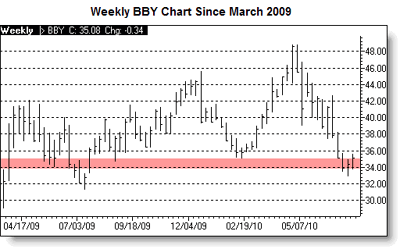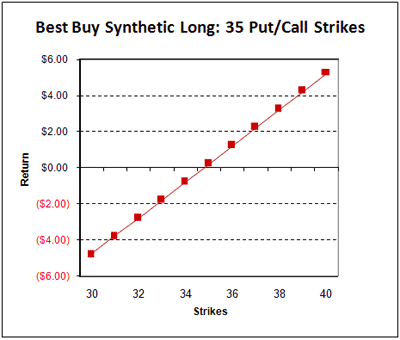The shares of Best Buy Co., Inc. (BBY) have struggled during the past several weeks, pulling back sharply from their late-April peak near $50. The electronics retailer has been negatively impacted by concerns of a slowing US economic recovery, and the stock is now testing long-term support in the $34-$35 region. This area has provided key support on several occasions since late-March 2009.
Options traders are pretty complacent when it comes to BBY's prospects, as the stock's Schaeffer's put/call open interest ratio (SOIR) of 0.91 ranks near the midpoint of its annual range. However, put buying is gaining traction on the International Securities Exchange (ISE) and Chicago Board Options Exchange (CBOE), with these exchanges reporting that more than two puts have been bought to open for every one call purchased during the prior two weeks. The resulting ten-day ISE/CBOE put/call volume ratio of 2.11 arrives above 92% of all those taken during the past year, meaning that options traders have rarely snatched up puts at a faster rate than calls during this time frame.
BBY puts have seen their popularity extend into today's trading, as more than 8,300 of these bearishly oriented options have traded so far. The most popular strike has been the August 35 put, where some 3,500 contracts have changed hands. However, a little bit of digging revealed a much more interesting trade located at the December 35 put.
Specifically, 120 December 35 puts traded at 12:04 pm on the ISE for the bid price of $3.48, or $348 per contract. Simultaneously, a block of 120 December 35 calls traded on the ISE for the ask price of $3.25, or $325 per contract. Given this data, it would appear that we are looking at a synthetic long position on Best Buy Co. Inc.
The Anatomy of a Best Buy Synthetic Long Position
Before we get into the particulars, a synthetic long attempts to replicate as closely as possible a long stock position. The trader typically buys at-the-money calls and sells at-the-money puts in equal numbers at the same strike with the same expiration date. By using options, the trader gains considerable leverage, allowing for greater returns on the position than those achieved by investing the same amount of money in a stock position.
Overall, the trader paid $3.25, or $325 per contract, for the 120 December 35 calls, and received a credit of $3.48, or $348 per contract, for selling 120 December 35 puts. As such, the position results in a credit of $0.23, or $23 per contract. For those curious readers out there, the total credit at initiation would have been $2,760.
The maximum profit on this trade is theoretically unlimited since there is no cap to how high BBY shares can rally. The maximum loss, while considerable, is limited to the strike price of the sold December 35 put minus the credit received, or $34.77, or $3,477 per contract. Breakeven, meanwhile, is calculated by subtracting the credit from the strike price of the purchased December 35 call, and arrives at $34.77. Below is a chart for a rough visual representation of the trade's profit/loss scenario:
Implied Volatility
Rising implied volatility is pretty neutral for a synthetic long trade. First, it lifts the value of both the purchased and the sold options, thus increasing the cost to buy back the sold put and boosting the premium received when selling the purchased call. At the time the position was entered, implied volatility for the BBY December 35 call was 36.95%, while implieds for the December 35 put were 37.07%.
By Joseph Hargett of Schaeffer’s Trading Floor Blog
























